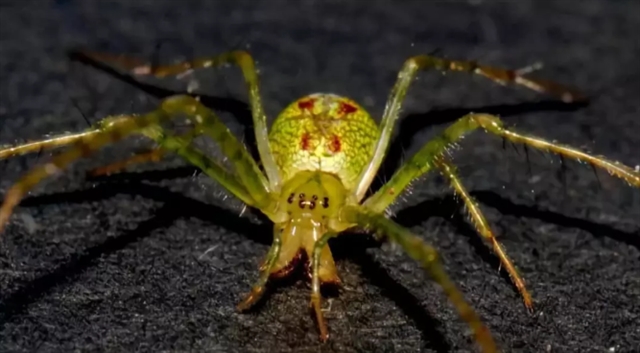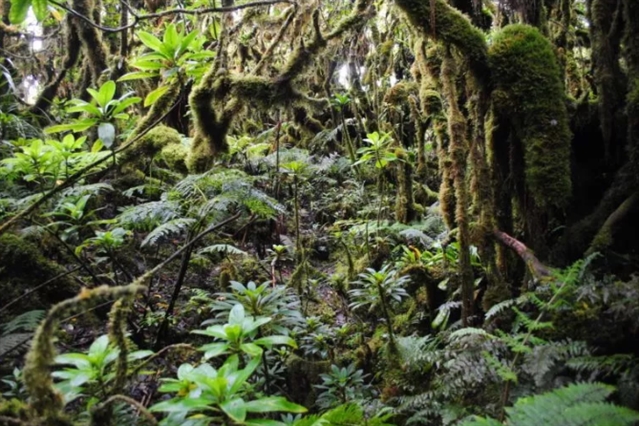论文标题:Co-occurrence of ecologically similar species of Hawaiian spiders reveals critical early phase of adaptive radiation
期刊:BMC Evolutionary Biology
作者:Darko D. Cotoras et al
发表时间: 2018/6/19
数字识别码:10.1186/s12862-018-1209-y
原文链接:https://bmcevolbiol.biomedcentral.com/articles/10.1186/s12862-018-1209-y?utm_source=Other_website&utm_medium=Website_links&utm_content=DaiDen-BMC-BMC_Evolutionary_Biology-Biology-China&utm_campaign=BMCS_USG_BSCN_DD_bmcevolbiol_Hawaiianspiders
适应性辐射是一种进化过程,不同的环境条件下,单个祖先可以迅速分化成多种物种。由于缺乏分化早期关键阶段的信息,我们对适应性辐射这个过程知之甚少。在BMC Evolutionary Biology近期发表的一篇研究中,Darko Cotoras和他的同事揭示了适应性辐射过程中缺失的一环。来看看Cotoras是怎么解释这一新发现的吧:

来自夏威夷毛伊岛Waikamoi保护区的Tetragnatha waikamoi蜘蛛
离大陆较远群岛长期以来一直都吸引着科研工作者,因为在这里生态环境与进化过程紧密结合,有助于加深我们对生物多样性形成过程的认识。
热点图分析提示夏威夷群岛中不同的岛屿是按照时间分布的,不同的岛屿形成地质年代梯度,因此具有不同阶段的生物学多样性。这些岛屿是简单独立的系统,有独特的地质年代,面积也不尽相同,这些特点使它们成为认识隔离情况下生命进化的理想“自然实验室”。
夏威夷群岛是多次引人注目的大规模多样化事件的发生地。群岛上有超过一千种果蝇种类,数十种蜜旋木雀和多种半边莲属植物。它们都是适应性辐射的例子。
适应性辐射是一个进化过程;在这个过程中单个祖先可以沿不同生态轴迅速分化成多种生物。这个过程究竟是如何发生的? 虽然已经有许多研究探究多样化发生的速度和生态转变的模式,但对于最初的步骤我们仍毫无头绪:单一物种如何向不同生态轴分化,而这一过程就发生在其母辈物种生活的地方?
在BMC Evolutionary Biology最近发表的一篇论文中,我们分析了长有长颚的长脚蛛属(Tetragnatha)夏威夷蜘蛛适应性辐射产生的相近物种的群体基因以探究这一问题。

夏威夷西毛伊岛Pu'u Kuku'i的原生夏威夷森林
该属中不同物种的区别在于它们的颜色:绿色、栗色、浅棕色还是深棕色,以及它们白天隐蔽的地方(绿叶、栗色苔藓、浅棕色嫩枝、深棕色树枝)。
考虑到蜘蛛仅在夜间行动,且视力非常有限,躲避白天捕食者的袭击可能是这些蜘蛛选择隐蔽色最主要的自然选择压力。最可能的捕食者是蜜旋木雀,蜘蛛是它们日常食物中的重要组成部分。
在辐射发生时,该物种倾向于从“较老”的岛屿逐渐扩散到“较年轻”的岛屿;不同的生态形态可能在分化过程中形成,即形成了具有不同生态形态的相近物种;并且部分地通过原位多样化产生了不同的生态形态,产生了与不同的生态形态密切相关的物种;在岛屿间扩散的过程中,已经提前预适应了新环境物种从“较老”的岛屿抵达“较年轻”的岛屿,此后分散在各处进行独立分化,分化过程中不改变其生态形态。
我们的疑问是,既然种群可以在不同地点进行独立分化且不改变生态形态,那它们又是在什么时候重新聚集到一起并开始互动的呢?
通过研究夏威夷群岛中“最年轻”岛屿上生态形态相同的邻近物种,我们便能够阐明适应性辐射过程的初始阶段。
我们的研究主要有以下几个发现。首先,相同物种的种群内结构高度规整,表明群体之间的第一次分化可能是在不同地点发生的。其次,我们发现,在分类群的焦点范围内,遗传学上不同的各谱系共存,但没有杂交的证据。
这些结果表明,这些遗传上学不同的物种在二次接触时已经产生了生殖隔离,而这种情况发生在生态分化之前。
这一结果与我们在“较老”岛屿上发现的情况并不符合,“较老”岛屿上邻近物种在生态学上是不同的(具有不同的生态形态)。因此,本研究突出了适应性辐射过程中的一个关键时期,在该阶段,具有相同生态形态的分化后且存在生殖隔离的分类群能有机会相互作用和影响。
摘要:
Background
The processes through which populations originate and diversify ecologically in the initial stages of adaptive radiation are little understood because we lack information on critical steps of early divergence. A key question is, at what point do closely related species interact, setting the stage for competition and ecological specialization? The Hawaiian Islands provide an ideal system to explore the early stages of adaptive radiation because the islands span ages from 0.5–5 Mya. Hawaiian spiders in the genus Tetragnatha have undergone adaptive radiation, with one lineage (“spiny legs”) showing four different ecomorphs (green, maroon, large brown, small brown); one representative of each ecomorph is generally found at any site on the older islands. Given that the early stages of adaptive radiation are characterized by allopatric divergence between populations of the same ecomorph, the question is, what are the steps towards subsequent co-occurrence of different ecomorphs? Using a transcriptome-based exon capture approach, we focus on early divergence among close relatives of the green ecomorph to understand processes associated with co-occurrence within the same ecomorph at the early stages of adaptive radiation.
Results
The major outcomes from the current study are first that closely related species within the same green ecomorph of spiny leg Tetragnatha co-occur on the same single volcano on East Maui, and second that there is no evidence of genetic admixture between these ecologically equivalent species. Further, that multiple genetic lineages exist on a single volcano on Maui suggests that there are no inherent dispersal barriers and that the observed limited distribution of taxa reflects competitive exclusion.
Conclusions
The observation of co-occurrence of ecologically equivalent species on the young volcano of Maui provides a missing link in the process of adaptive radiation between the point when recently divergent species of the same ecomorph occur in allopatry, to the point where different ecomorphs co-occur at a site, as found throughout the older islands. More importantly, the ability of close relatives of the same ecomorph to interact, without admixture, may provide the conditions necessary for ecological divergence and independent evolution of ecomorphs associated with adaptive radiation.
阅读论文原文,请访问
https://bmcevolbiol.biomedcentral.com/articles/10.1186/s12862-018-1209-y?utm_source=Other_website&utm_medium=Website_links&utm_content=DaiDen-BMC-BMC_Evolutionary_Biology-Biology-China&utm_campaign=BMCS_USG_BSCN_DD_bmcevolbiol_Hawaiianspiders
期刊介绍:BMC Evolutionary Biology is an open access, peer-reviewed journal that considers articles on all aspects of molecular and non-molecular evolution of all organisms, as well as phylogenetics and palaeontology.
2016 Journal Metrics
Citation Impact
3.221 - 2-year Impact Factor
3.628 - 5-year Impact Factor
1.266 - Source Normalized Impact per Paper (SNIP)
(来源:科学网)
特别声明:本文转载仅仅是出于传播信息的需要,并不意味着代表本网站观点或证实其内容的真实性;如其他媒体、网站或个人从本网站转载使用,须保留本网站注明的“来源”,并自负版权等法律责任;作者如果不希望被转载或者联系转载稿费等事宜,请与我们接洽。